Want it delivered daily to your inbox?
-
If the recent high-profile defaults were the beginning of a broader credit cycle, then default rates would be going up.
Instead, default rates are falling, and earnings expectations are revised higher, see the first two charts below.
At the same time, the Atlanta Fed expects GDP growth to come in at 3.8%, significantly above the CBO’s 2% estimate of long-term growth for the US.
The bottom line is that the US economy remains incredibly resilient.
Yes, the labor market shows slower job growth, but the observed slowdown in employment growth is not driven by weaker labor demand but by weaker labor supply because of tighter immigration restrictions, including higher fees on H-1Bs. The Fed has made that clear in this paper. In addition, low jobless claims and the recent rise in the daily data for job openings confirms that the slower job growth is not driven by weaker labor demand but by lower labor supply, see the third chart.
Combined with dollar depreciation, lower oil prices and the One Big Beautiful Bill starting to take effect in a few weeks, the upside risks to growth and inflation are significant, see the fourth chart.
In short, a data dependent Fed would come to the conclusion that it should not cut interest rates next week.
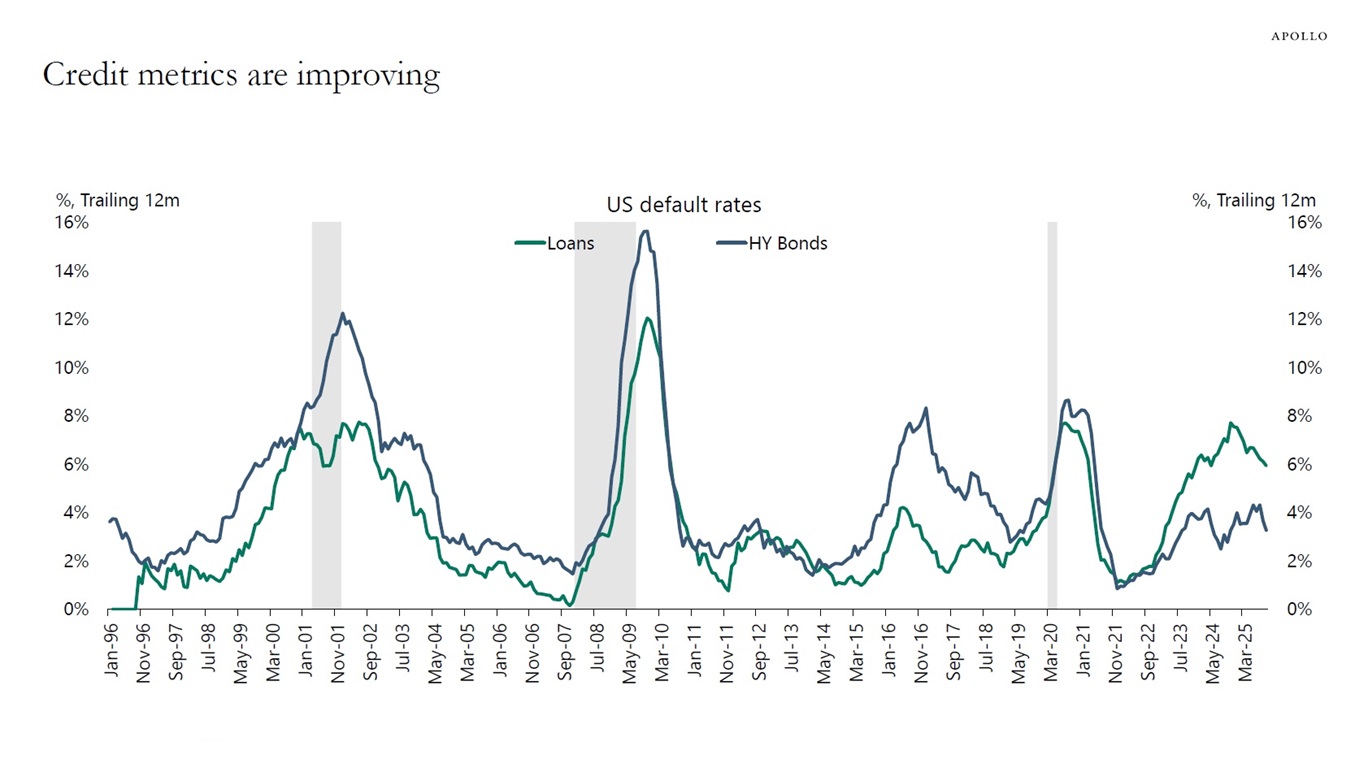
Sources: Moody’s Analytics, Apollo Chief Economist 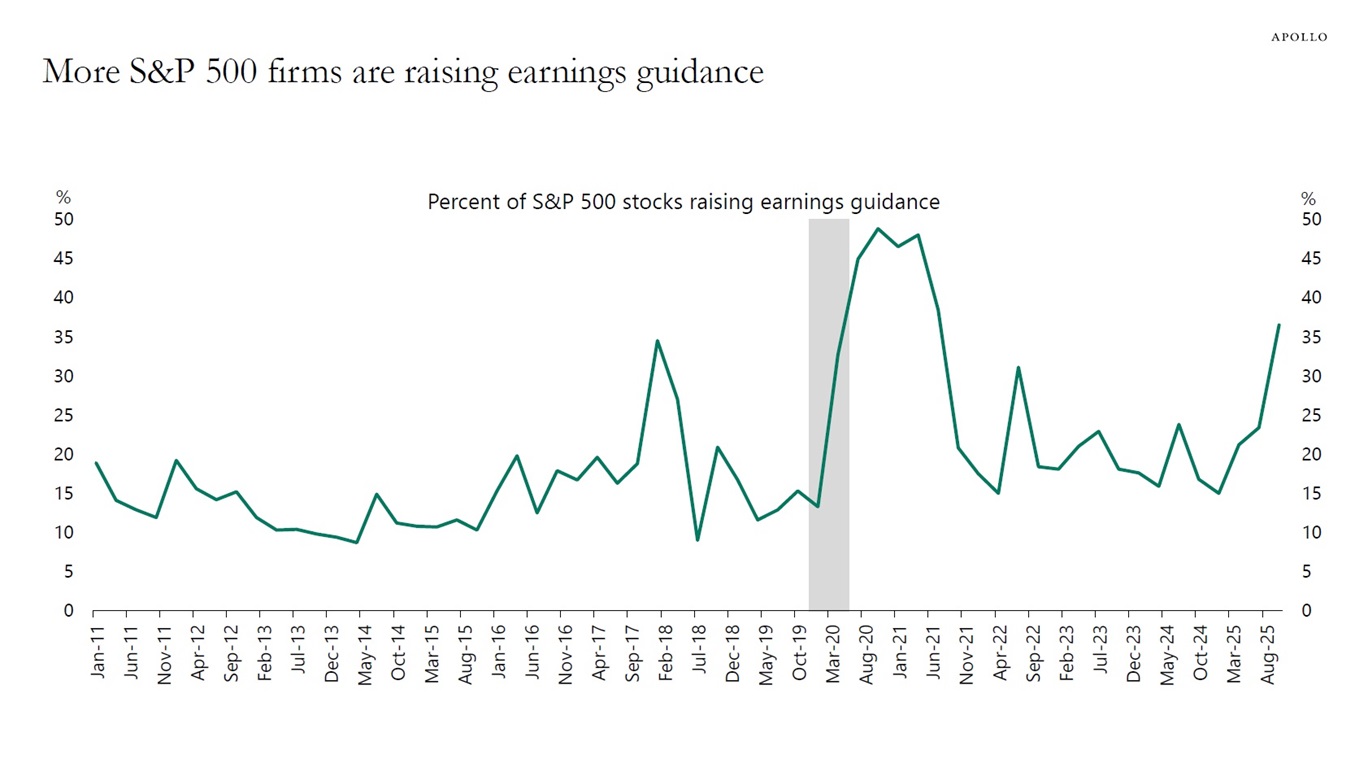
Sources: Bloomberg, Apollo Chief Economist 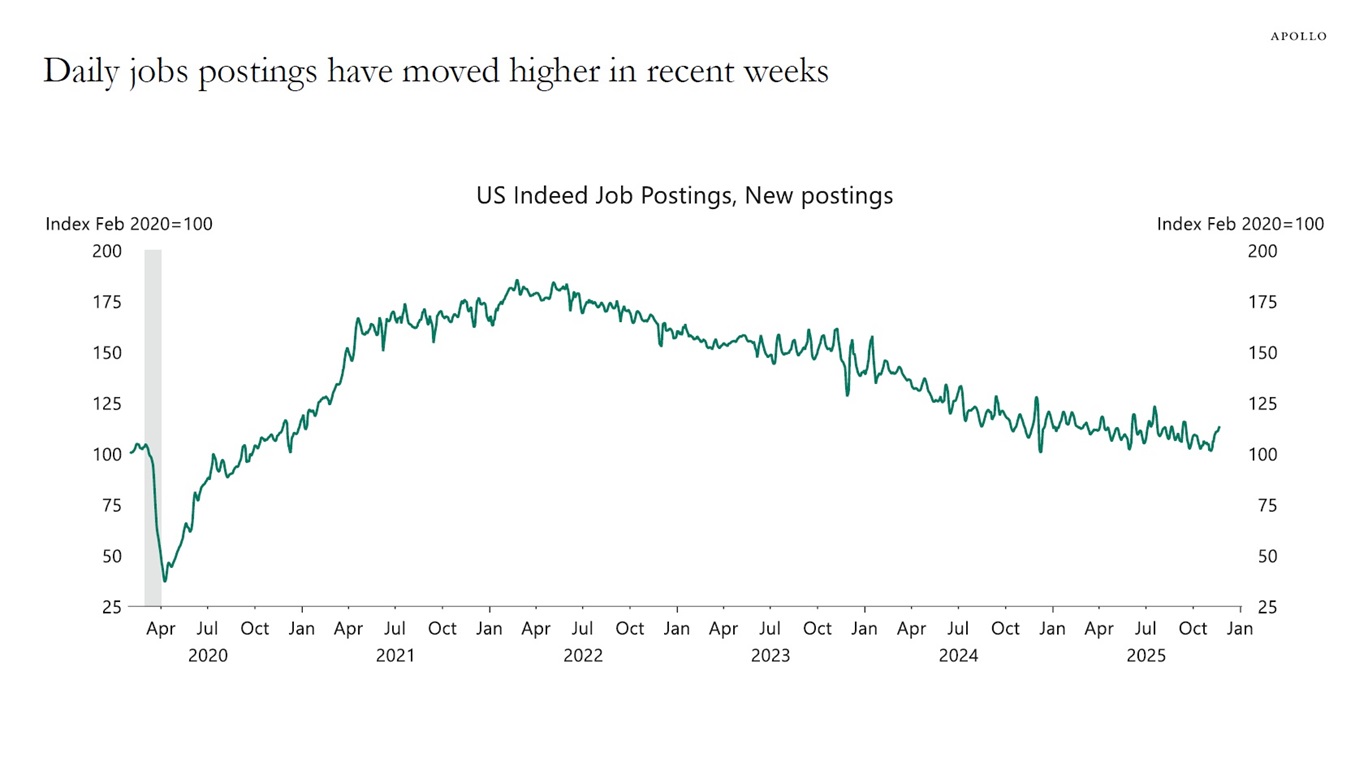
Sources: Indeed, Bloomberg, Macrobond, Apollo Chief Economist 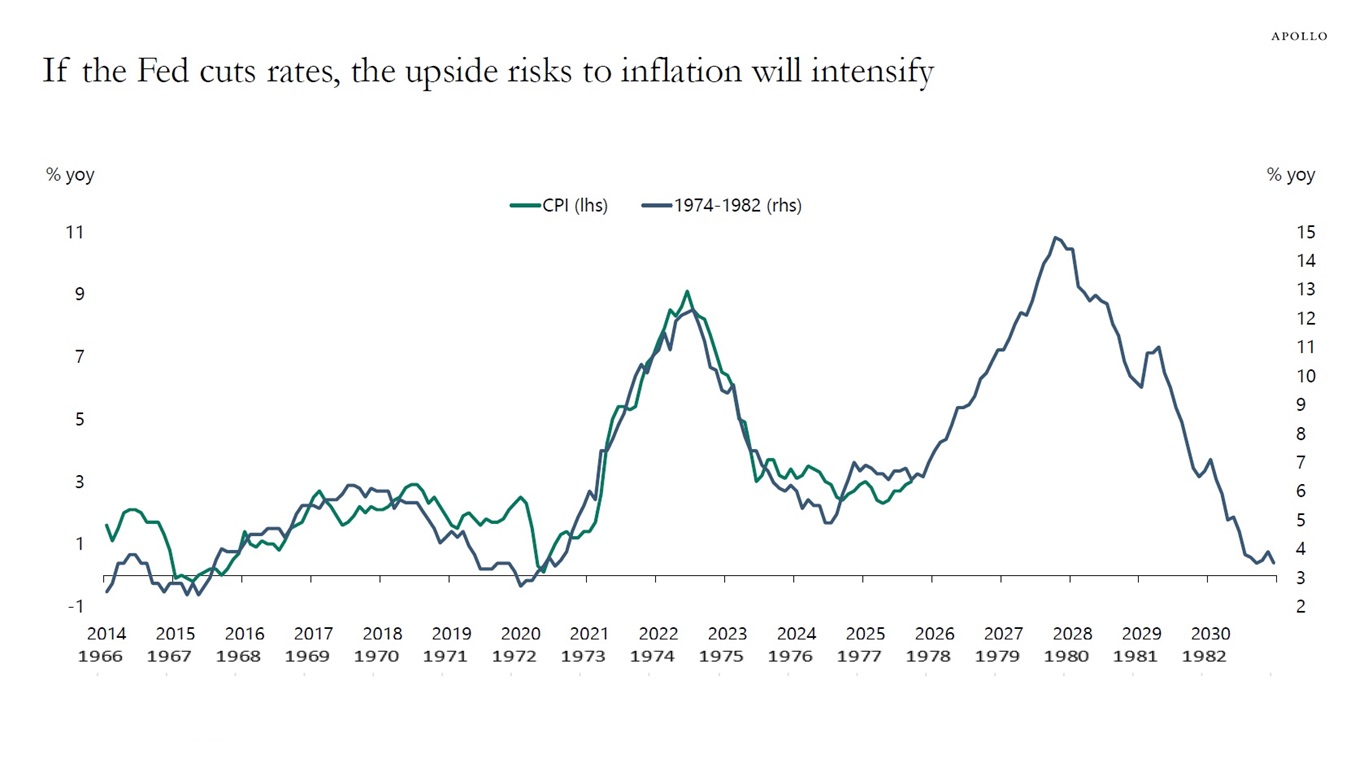
Sources: BLS, Bloomberg, Apollo Chief Economist See important disclaimers at the bottom of the page.
-
There are always upside and downside risks to the outlook. Below are five things we are watching going into 2026.
1. The US economy starts re-accelerating because of the fading trade war shock and the One Big Beautiful Bill, and inflation begins to move higher from an already high level.
2. The global industrial renaissance boosts global growth with more and more countries focusing on homeshoring advanced manufacturing capacity, investing in infrastructure, energy, defense and supply chains.
3. The new Fed Chair lowers interest rates purely for political reasons.
4. AI bubble bursting results in a major correction of Mag 7 equity prices and slows capex spending and high-end consumer spending.
5. Dramatic increase in the supply of fixed income in 2026, coming from growing government deficits and hyperscaler issuance, puts upward pressure on rates and credit spreads.
See important disclaimers at the bottom of the page.
-
Swaption volatility remains very low despite significant debate about what the Fed will do at its next meeting, see chart below. In other words, the market is not expecting sharp moves in yields over the next three months.
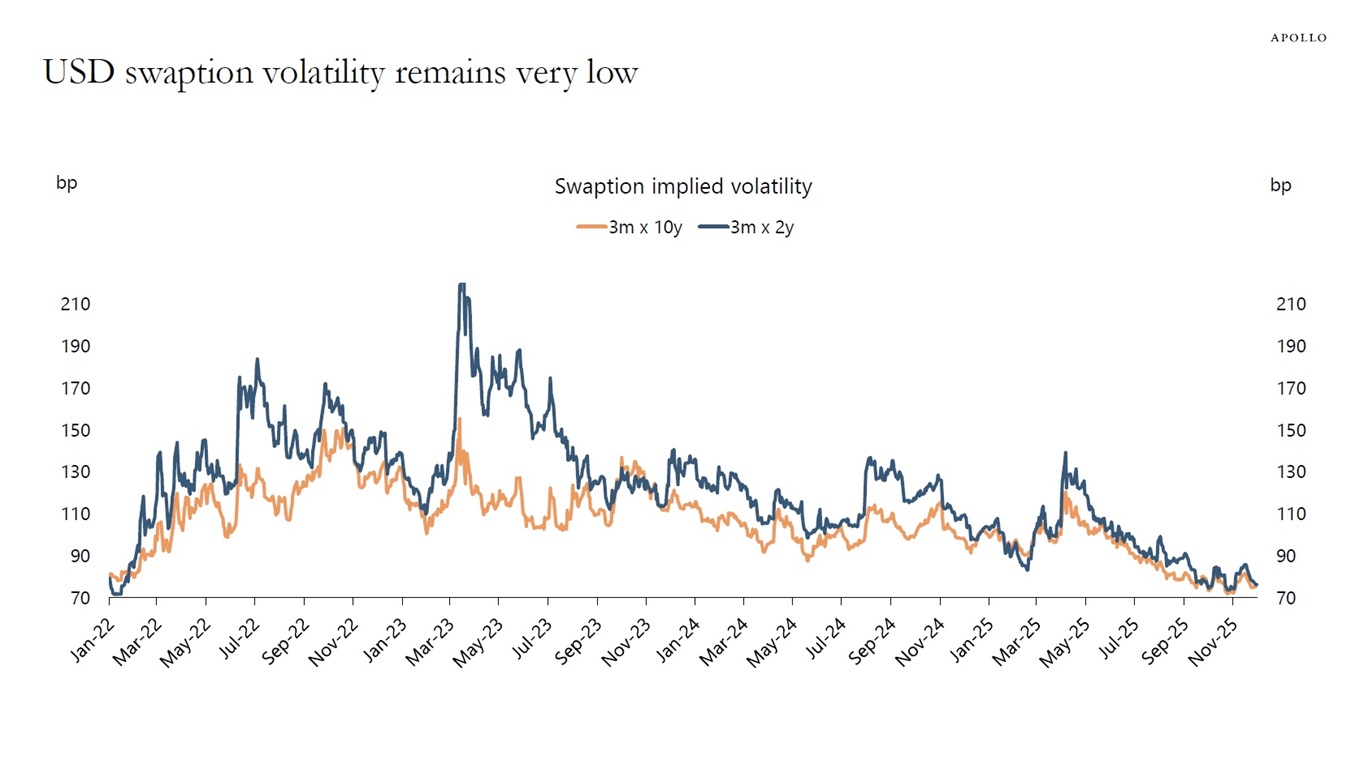
Tickers: USSNAC10 and USSNAC2. Sources: Bloomberg, Apollo Chief Economist See important disclaimers at the bottom of the page.
-
The CBO estimates that the One Big Beautiful Bill will boost GDP growth next year by 0.9%, see chart below. The main factor in the bill is that, starting January 1, 2026, businesses can immediately deduct capital expenses, such as investments in equipment and R&D. This is a major tailwind for the economy in 2026.
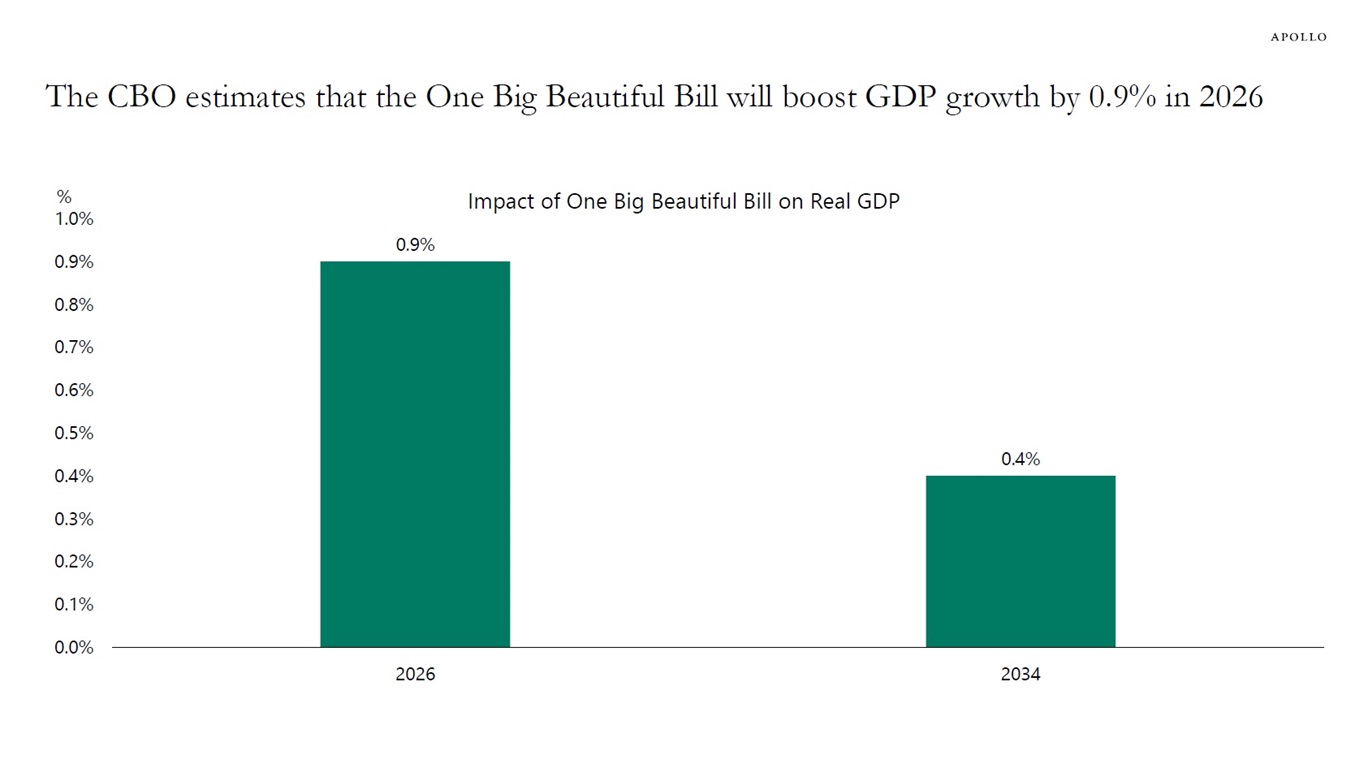
Sources: CBO, H.R. 1, One Big Beautiful Bill Act, Apollo Chief Economist See important disclaimers at the bottom of the page.
-
European companies typically allocate more of their resources to tangible assets, such as property, plant and equipment, resulting in a higher tangible asset ratio than US companies. In contrast, US firms invest more heavily in intangible assets like software, brand value and intellectual property rights, see chart below.
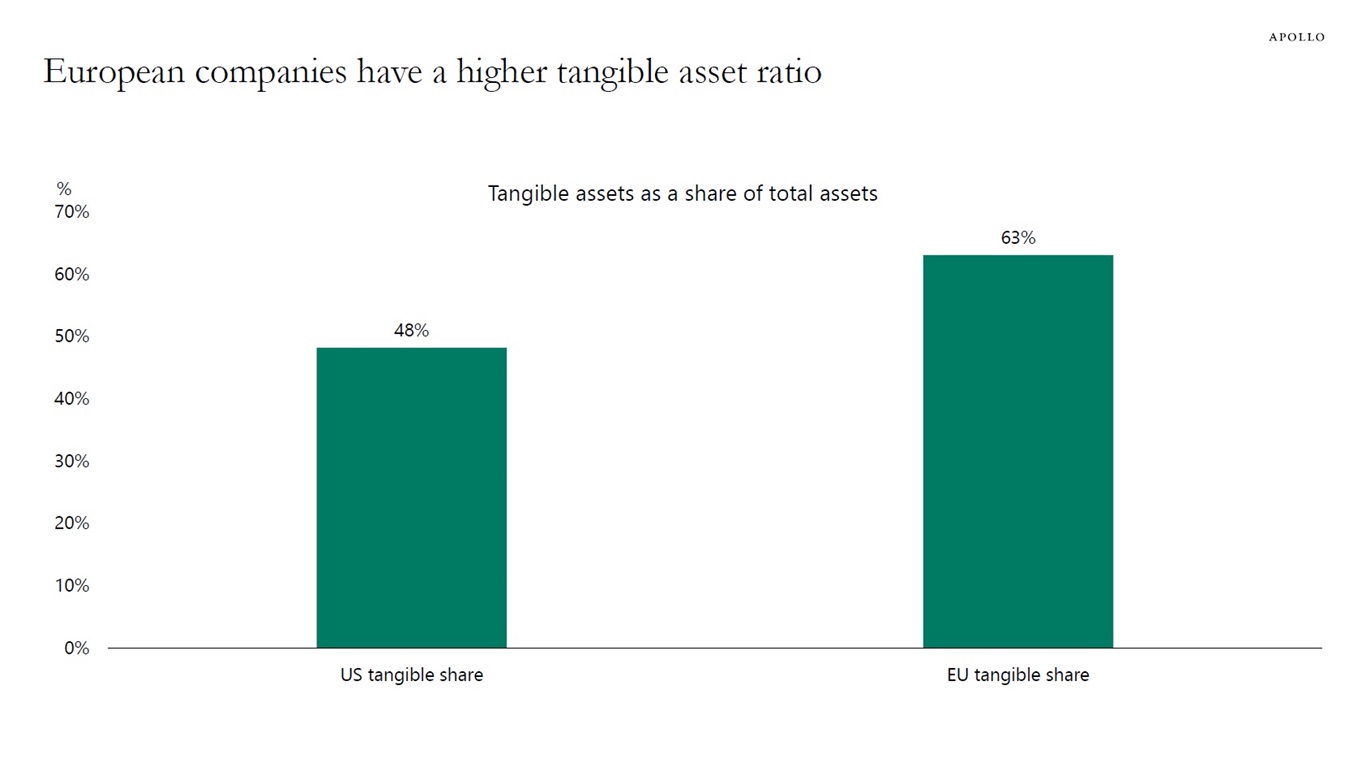
Note: Tangible assets include fixed tangible assets like plants, equipment and property. Sources: Financial accounts of United Sates, FRB, Haver Analytics, EIB Investment Survey 2024, Apollo Chief Economist See important disclaimers at the bottom of the page.
-
The chart below shows what types of assets households own across the wealth distribution.
Households with lower asset holdings mainly own their home and their car. Wealthier households mainly own business assets and stocks.
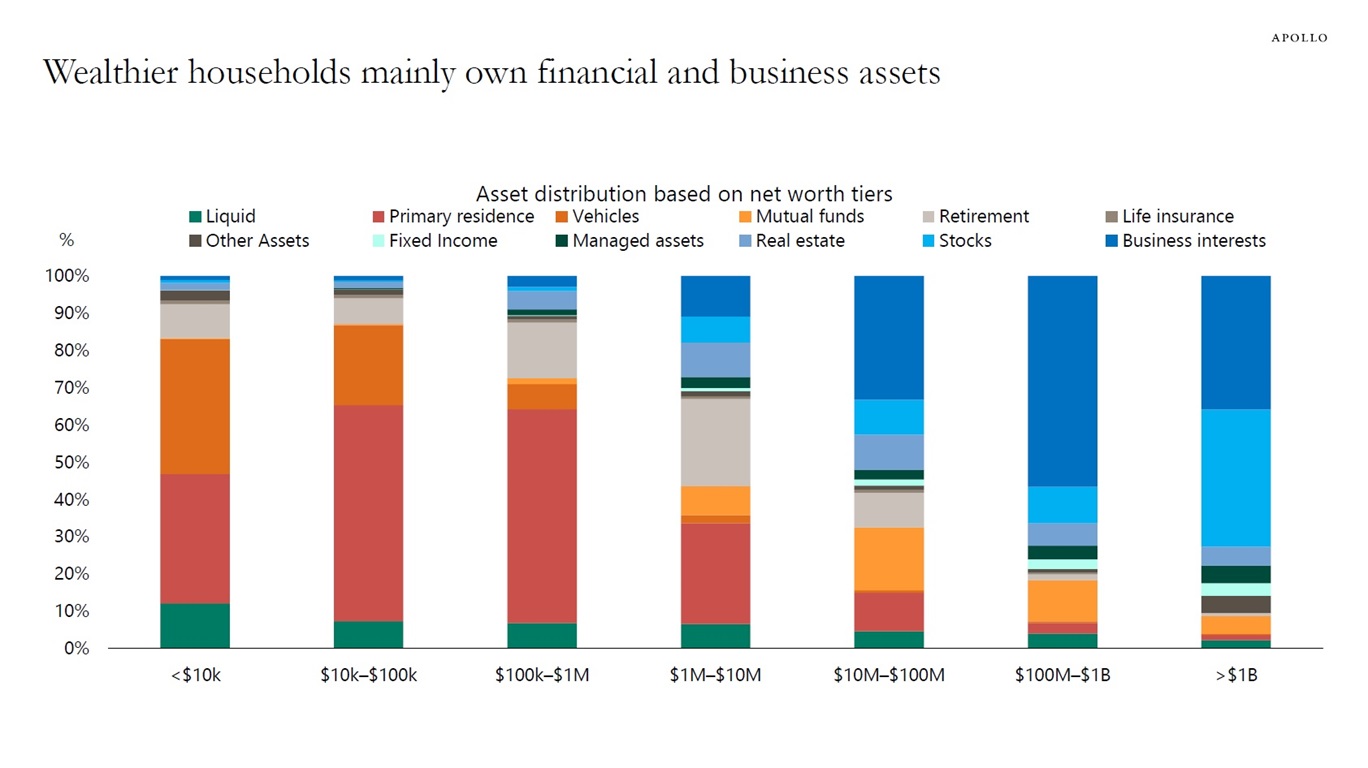
Sources: Federal Reserve Survey of Consumer Finances, Apollo Chief Economist See important disclaimers at the bottom of the page.
-
The weekly data for US consumer spending continues to show solid growth in private consumption, see chart below.
In other words, there is no need for the Fed to cut rates to boost consumer spending.
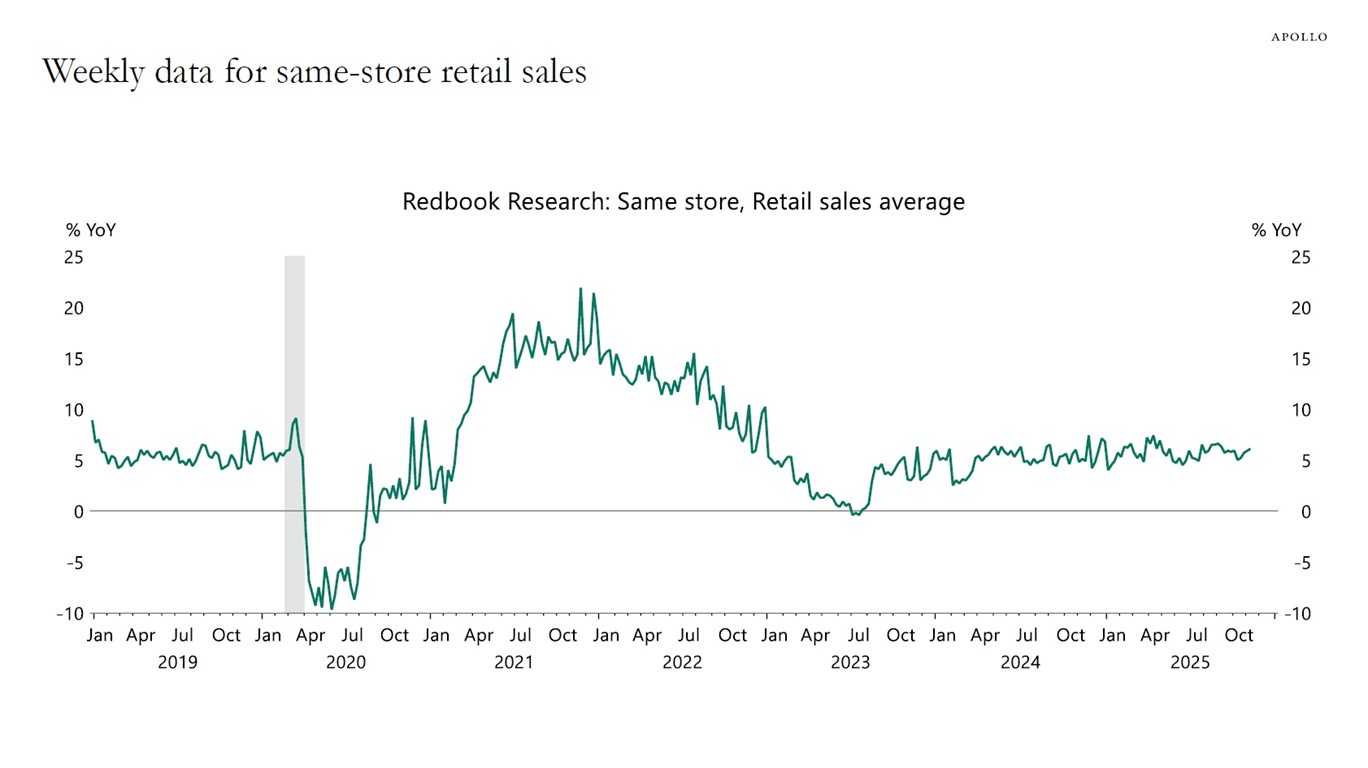
Sources: Redbook Research Inc., Macrobond, Apollo Chief Economist See important disclaimers at the bottom of the page.
-
Data from the Census Bureau and Ramp shows that AI adoption rates are starting to flatten out across all firm sizes, see charts below.
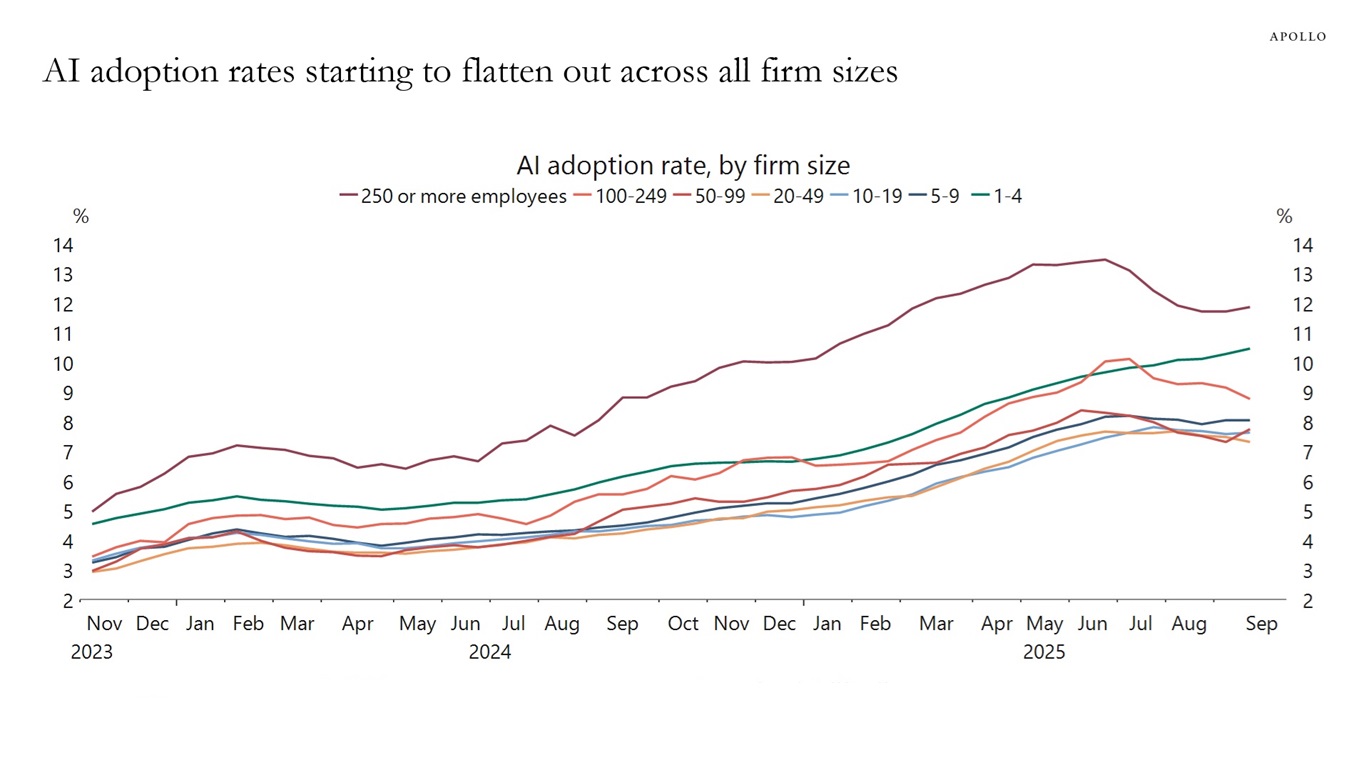
Note: Data is six-survey moving average. The survey is conducted bi-weekly. Sources: US Census Bureau, Macrobond, Apollo Chief Economist
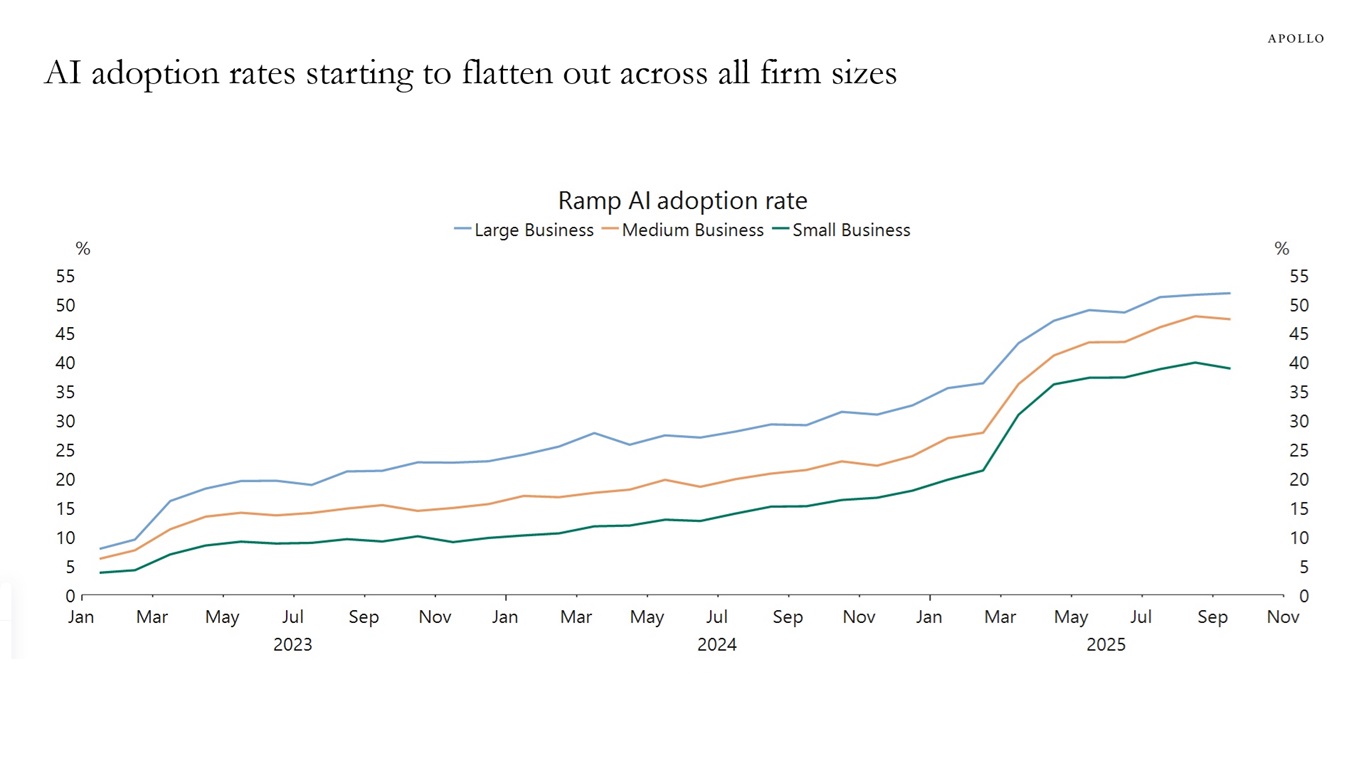
Note: Ramp Al Index measures the adoption rate of artificial intelligence products and services among American businesses. The sample includes more than 40,000 American businesses and billions of dollars in corporate spend using data from Ramp’s corporate card and bill pay platform. Sources: Ramp, Bloomberg, Macrobond, Apollo Chief Economist See important disclaimers at the bottom of the page.
-
The chart below shows that foreigners come to the US to earn higher yields and invest in AI.
Since Liberation Day, foreign appetite for US assets has been robust. This is the reason why the US dollar has been trending higher over the past six months.
The chart below shows that since May, foreigners have been strong buyers of AI and US fixed income, including credit.
With rates higher for longer and the AI story continuing, foreign demand for US assets will remain strong.
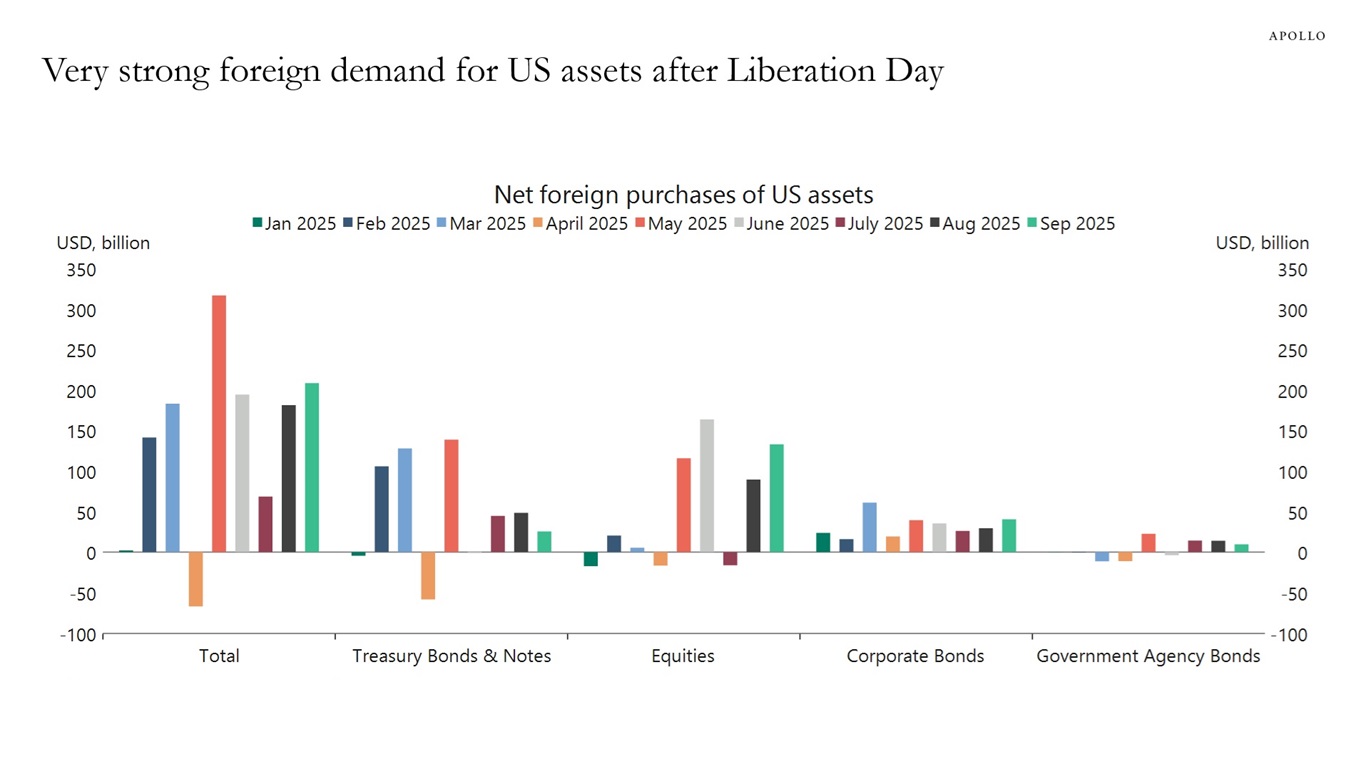
Sources: US Department of Treasury, Macrobond, Apollo Chief Economist See important disclaimers at the bottom of the page.
-
Bitcoin and the Nasdaq Composite are normally highly correlated, but that correlation has broken down in recent weeks with a much sharper drop in the price of Bitcoin, see chart below.
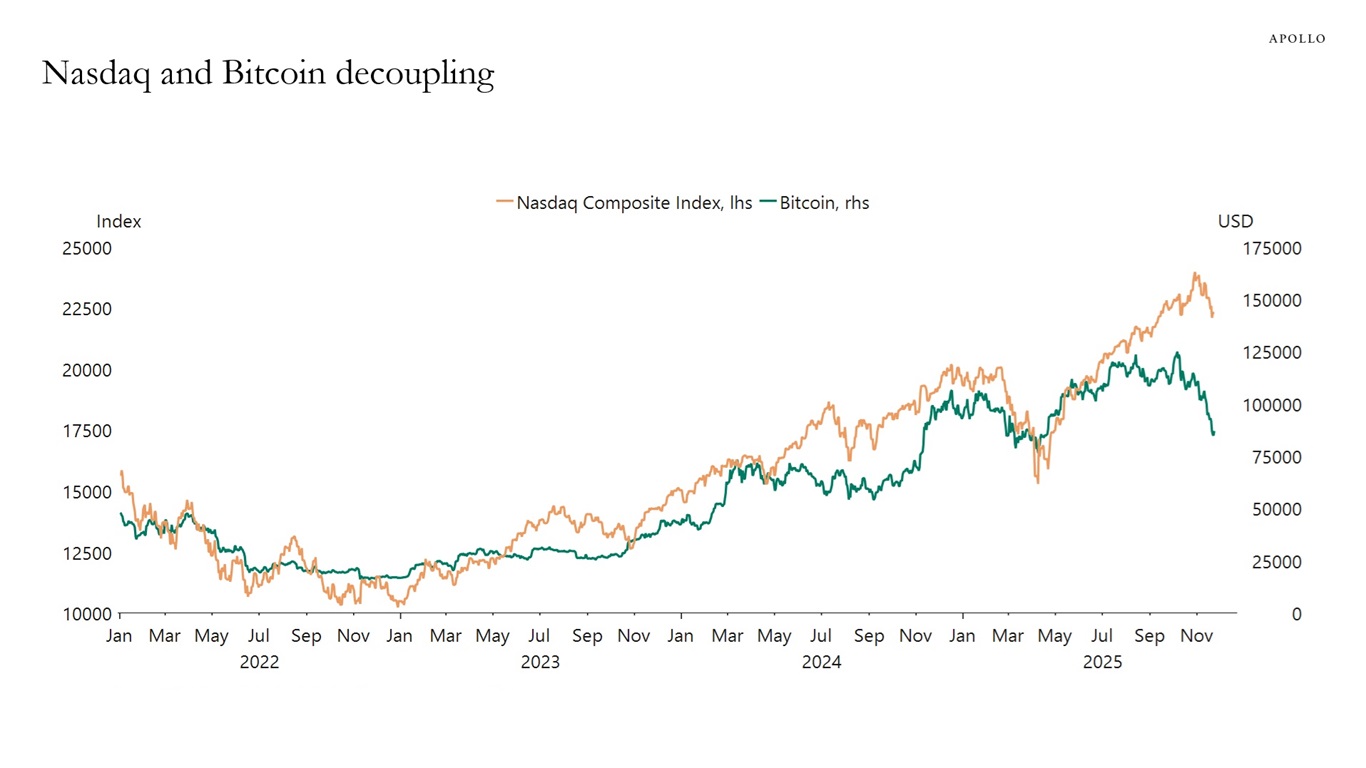
Sources: Nasdaq, Macrobond, Apollo Chief Economist See important disclaimers at the bottom of the page.
This presentation may not be distributed, transmitted or otherwise communicated to others in whole or in part without the express consent of Apollo Global Management, Inc. (together with its subsidiaries, “Apollo”).
Apollo makes no representation or warranty, expressed or implied, with respect to the accuracy, reasonableness, or completeness of any of the statements made during this presentation, including, but not limited to, statements obtained from third parties. Opinions, estimates and projections constitute the current judgment of the speaker as of the date indicated. They do not necessarily reflect the views and opinions of Apollo and are subject to change at any time without notice. Apollo does not have any responsibility to update this presentation to account for such changes. There can be no assurance that any trends discussed during this presentation will continue.
Statements made throughout this presentation are not intended to provide, and should not be relied upon for, accounting, legal or tax advice and do not constitute an investment recommendation or investment advice. Investors should make an independent investigation of the information discussed during this presentation, including consulting their tax, legal, accounting or other advisors about such information. Apollo does not act for you and is not responsible for providing you with the protections afforded to its clients. This presentation does not constitute an offer to sell, or the solicitation of an offer to buy, any security, product or service, including interest in any investment product or fund or account managed or advised by Apollo.
Certain statements made throughout this presentation may be “forward-looking” in nature. Due to various risks and uncertainties, actual events or results may differ materially from those reflected or contemplated in such forward-looking information. As such, undue reliance should not be placed on such statements. Forward-looking statements may be identified by the use of terminology including, but not limited to, “may”, “will”, “should”, “expect”, “anticipate”, “target”, “project”, “estimate”, “intend”, “continue” or “believe” or the negatives thereof or other variations thereon or comparable terminology.






